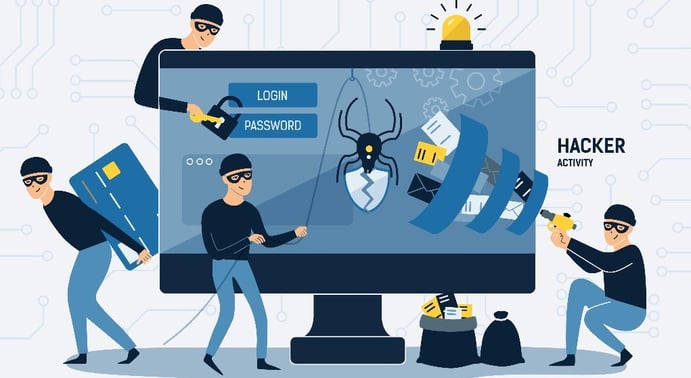
As businesses continue to leverage digital technology at an ever-growing pace, the importance of safeguarding information is at an all-time high. Companies in all sectors continue to integrate more sophisticated technologies into their operations, continually heightening the potential risk of cybersecurity breaches. In this article, we talk about a few common ways organizations are attacked and the signs to look for to determine if you’ve been breached.
Cyber-Attacks Have Been On The Rise
2018 saw a 350% increase in ransomware attacks, a 250% increase in business email compromise attacks, and a 70% increase in phishing attacks.
The problem is most companies aren’t aware of a breach until it’s too late. Recent high profile breaches have increased consumer skepticism of personal data safeguarding procedures. But it’s not just Fortune 500 companies dealing with severe breaches; nearly half of all cyber attacks occur in small businesses.
According to the U.S. Securities and Exchange Commission, the cost of a cyber-data breach rose from $4.9 million in 2017 to $7.5 million in 2018. The importance of establishing a strong cybersecurity architecture is more crucial than ever to long term business growth, brand loyalty, and customer retention.
Monitoring cyber systems and establishing visibility over your cybersecurity architecture is crucial to stonewalling potential threats and protecting sensitive information. Inadequate system security can lead to breaches that can manifest in several forms.
Ransomware Attacks
Ransomware has become one of the most prevalent forms of cyber attacks in today’s tech-driven world. According to a recent report, a 500% increase in ransomware attacks against businesses occurred in Q1 2019 compared to Q1 2018.
Ransomware is a cyber threat that involves locking and encrypting a user’s computer data rendering it inaccessible. As the name implies, cybercriminals threaten to permanently block data access unless monetary ransom demands are met within a specified timeframe. Often times organizations aren’t aware of an attack until an employee has stated their files have been encrypted. By this time it's too late, your organization has been breached.
Regaining access to valuable data can come at a steep cost. According to a recent report, the average ransom amount has doubled to $13,000 in one year as cyber attack methods have become increasingly sophisticated.
Ransomware can penetrate cybersecurity infrastructures in different ways. Phishing emails may contain malicious attachments that can infect operational systems or users may simply click on the links of websites that have been compromised.
Ransomware can be difficult to track and most users are unaware that they have become victims until it’s too late. If you find that several of your personal files have been encrypted, you may already be at risk. File locking malware can be lucrative for criminals and could cost your business thousands of dollars, not to mention the trust of your consumer
Internal Phishing
Internal phishing involves sending emails from one trusted user to another within the same organization. Sophisticated hackers will thoroughly research executive-level targets and gather as much data as possible through web searches and publicly available information. They may even cite company details to enhance their credibility. Referencing recent public events, social media campaigns, or organizational changes within a company can make the emails of hackers appear to be more believable.
Sometimes referred to as Business Email Compromise (BEC), this type of scam targets companies that use wire transfers. By impersonating high profile executives, scammers request immediate funds to accounts they control.
A recent FBI report cited total adjusted losses from BEC campaigns at over $1.2 billion in 2018, nearly doubling losses of $676 million from 2017.
Employees with access to company bank accounts are targeted through seemingly legitimate transfer requests from what appears to be an internal associate. In reality, funds are directly siphoned to accounts owned by criminal enterprises.
Without properly validating the legitimacy of these requests, companies may be subject to devastating financial losses. It sounds obvious, but any employee that receives an inquiry to transfer funds should double and triple check the validity of the request. Internal phishing campaigns have proved to be a lucrative criminal enterprise that is growing at an exponential rate.
If the fraud goes undetected within a reasonable timeframe, large sums of money could be lost forever. Enterprise security is essential for protecting a company’s financial interests and privacy.
Insider Attacks
The vast majority of companies use cybersecurity resources to focus on external cyberattacks. However, threats don’t always come from outside organizations as internal users can present several concerns. In fact, a 2019 Verizon Data Breach investigations report cited that 34% of all breachers were the result of insider attacks.
A single insider attack incident can cost companies $513,000 according to a 2018 Ponemon Institute study.
Insiders present a unique challenge due to their familiarity with network architectures and internal controls. Employees are privy to sensitive documents ranging from Social Security numbers to company proprietary information.
Unhappy or disgruntled employees can take advantage of this knowledge and seek to destroy the company from the inside. They may choose to delete critical files, wipe system data, or even sell company secrets to competitors. Terminated employees can wreak havoc on entire network systems sabotaging everything from servers to data storage. Often times organizations do not know they have been subject to an internal attack; for example until a competitor goes to market with an identical product shortly before the scheduled release or in other cases the organization may realize their customer information has been stolen and are being targeted by a competitor.
As these types of threats become more commonplace, there is an increasing need for organizations to protect company assets and monitor their technology while minimizing insider attacks.
Security Monitoring: Ensure You Have The Visibility To Prevent Cyber Breaches
Most organizations that have experienced a breach, such as those outlined above, lack any type of monitoring solution and, therefore, catch the attack after it has happened. Organizations struggle to retain proficient in-house IT expertise due to the high demand for skilled security experts and limited financial resources. So oftentimes a monitoring solution is an afterthought.
But more companies are outsourcing security monitoring to managed service providers as a way of providing 24/7 cyber protection and support. TBConsulting’s Cybersecurity Solutions provide complete system support to help stay ahead of potential threats and vulnerabilities. Organizations can have peace of mind that sensitive employee documents, proprietary information, and other valuable data are kept secure and protected.
By implementing monitoring solutions, we can reduce the risk of cyber attacks while keeping your company’s reputation and financial assets safeguarded. Many cybersecurity architecture breaches aren’t recognized until it’s too late. Don’t let your company fall victim to cyber attackers due to lack of visibility of security vulnerabilities.
Still unsure how to monitor or prevent breaches? Learn more about how TBC’s managed cybersecurity offering can provide this critical protection of your data and your business.


